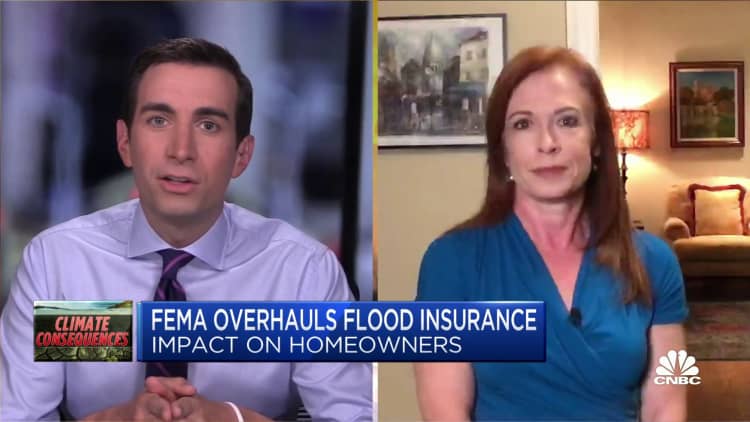
Climate change and its devastating impact are accelerating faster than ever, according to a new report from the United Nations' Intergovernmental Panel on Climate Change. Hurricanes are becoming stronger, rainfall heavier and flood risk higher. Yet, America's National Flood Insurance Program hasn't changed at all since its inception.
But it is about to.
Under the current program, the Federal Emergency Management Agency provides $1.3 trillion in coverage for more than 5 million policy holders in 23,500 communities nationwide. Homeowners in FEMA-designated flood zones are required to purchase flood insurance, but others do so voluntarily. Nearly one-third of NFIP policyholders are not mandated to carry it.
Starting on Oct. 1, the program will undergo a complete overhaul to make insurance pricing more accurately reflect each property's unique flood risk. Finally, climate change will be factored in.
"No question that this is the most substantive change to the program going back to 1968," said David Maurstad, deputy associate administrator for federal insurance and mitigation and senior executive of the flood insurance program.
"What we found out was that many folks with lower-value homes were paying more than they should, and those that had higher-value homes were paying less than they should. And we have a responsibility to make sure that we have actuarily sound, fair, and equitable rates. And so that's what's driving the change."
Today, federal flood insurance is based on the property's elevation and whether it has a 1% annual chance of flooding.
Under the new model, FEMA will also look at the home's replacement cost; whether the risk is rainfall, river or coastal flooding; and how close the property is to the source of the potential flooding. Most important, FEMA will now factor in future catastrophic modeling from climate change, including sea level rise, drought and wildfires.
Right now, the owner of a $1 million Florida home and the owner of a $200,000 Montana home are paying the same rates for insurance, even though their risk levels are decidedly different. Under the new model, the Florida owner would almost certainly pay more.
Maurstad says rates will go up for some and down for others. The majority of homeowners, however, will see rates go up about 10%, which is the normal annual increase.
"It's just important that we address that inequity that the lower-value homes shouldn't be subsidizing the higher-value homes going forward," he said.
This shift will inevitably change the value of some homes. The costs incurred by any home are factored into its value, whether those costs are insurance, taxes, maintenance on an older home, or the home's location.
"You can think of it as revenue coming in and expenses going out," said Matthew Eby, founder and executive director of First Street Foundation, which calculates flood risk scores for every home in America. Those scores are currently posted on some of the nation's largest home listing sites, including Realtor.com and Redfin.
"Depending on how much that insurance goes up is going to correlate perfectly to the value of that home for any new homebuyer who comes in and says, 'This home looks great, but now I have to pay $6,000, $10,000,' whatever it might be, a year in flood insurance, which is just going to take away from the value of the actual asset itself," he said.
Covering rising costs
The change in the NFIP calculation is not just to bring better equality to the program but also to help sustain it. As storm damage increases, FEMA is increasingly paying billions of dollars out to homeowners who are uninsured.
Hurricane Harvey in Houston was a stark example. More than 200,000 homes were damaged or destroyed, and three-quarters of them had no flood insurance, as many were outside FEMA flood zones. Flood zones are updated only every five years, by congressional mandate.
During its reauthorization process this fall, FEMA will also put forward more proposals to make the program more fiscally stable.
"No question we need to close the insurance gap. Not enough people in the high-risk area have the coverage they need to be able to be on the path to recovery after a flood event," Maurstad said. "There's just too much disaster, suffering, going on that we can minimize if we are able to have more people have the coverage they need."
He said FEMA has proposed a means-tested affordability program that will help low-to-moderate- income individuals pay for the flood insurance that they need.
"There's no question with climate change and the changing conditions that if we do nothing, the program is not going to be sustainable."


